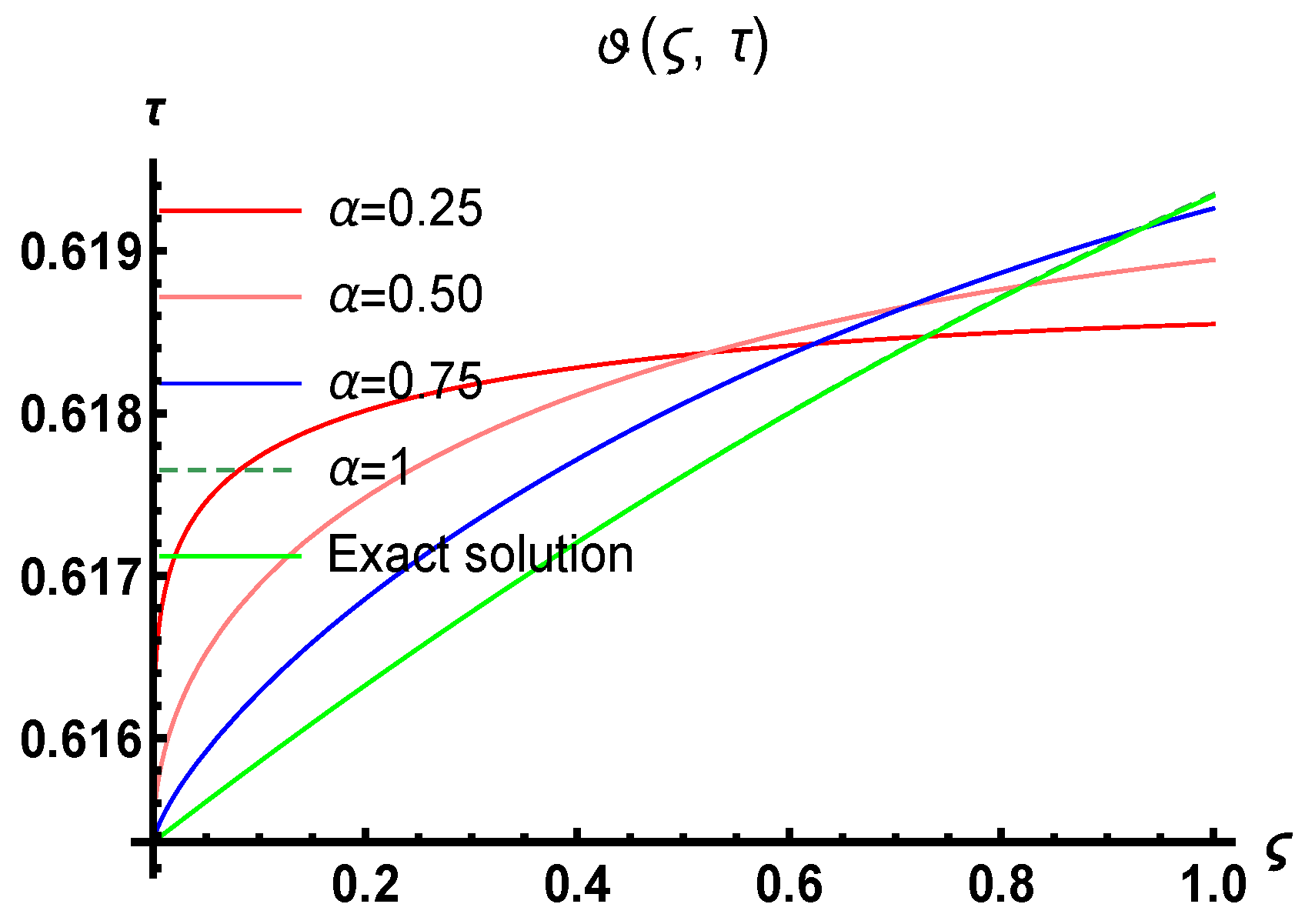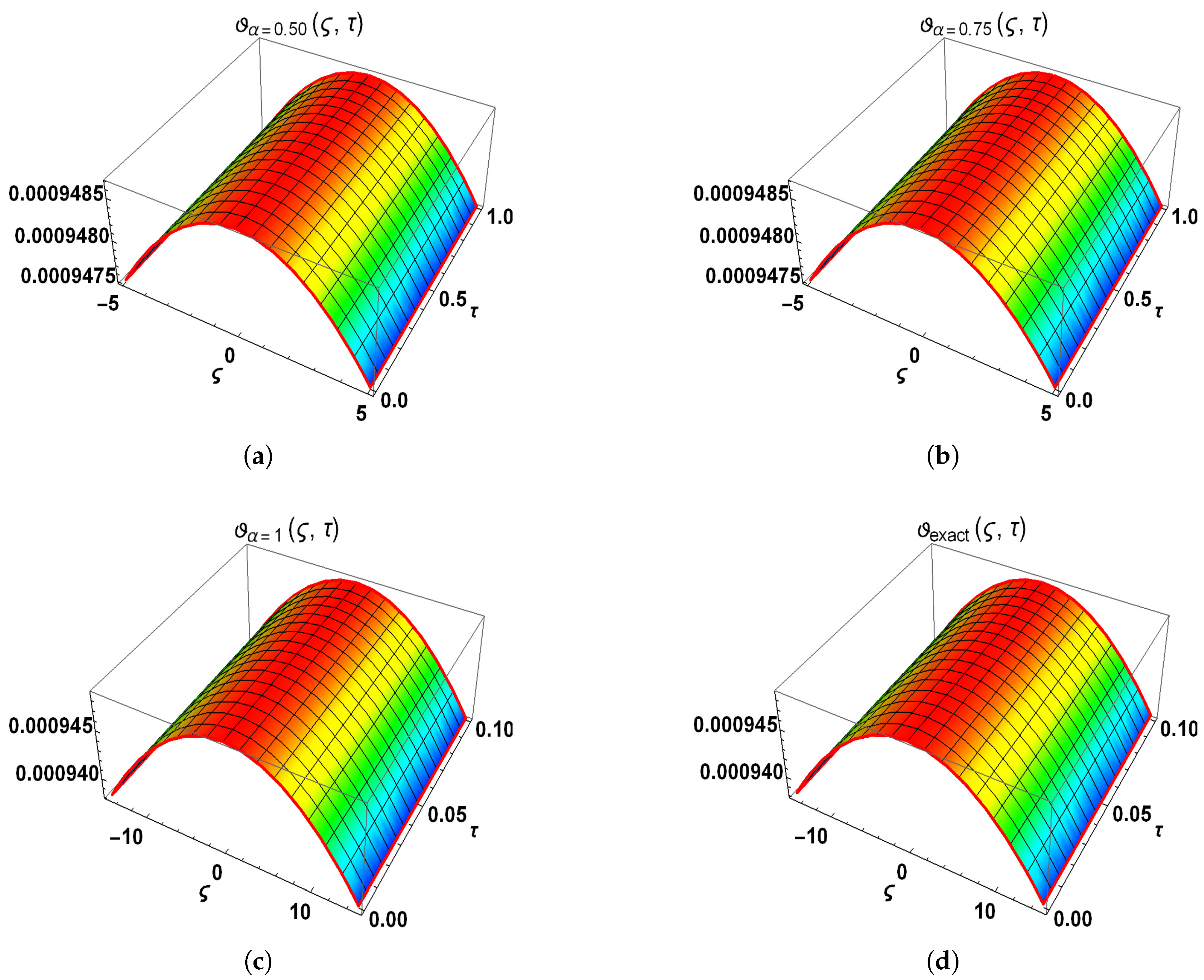Computational Study of Time-Fractional Kawahara and Modified Kawahara Equations with Caputo Derivatives Using Natural Homotopy Transform Method
Abstract
:1. Introduction
2. Basic Definitions of Fractional Calculus and Natural Transform
3. Formulation of Natural Homotopy Transform Scheme
- Step 3. The exact solution of Equation (5) is specified asIn this context, denotes a homotopy variable; however, serves as its first value. On the other side, the nonlinear factor associated with the homotopy parameter is defined asThe following formula can be employed to compute He’s parameters:Through connecting Equations (8) and (9), we derive Equation (7) as follows:
- Step 4. Upon conducting an analysis of p on the two sides, the resulting outcome is presented as
- Step 5. As a result, we are able to summarize the findings of this iterative series as follows:
4. Natural Transformation over Existence and Convergence Analysis
4.1. Existence of NT with Sufficient Condition
4.2. Uniqueness Theorem for NHTS
4.3. Convergence Study of NHTS
5. Numerical Problems
5.1. Problem 1
5.2. Problem 2
6. Results and Discussion
7. Conclusions
Author Contributions
Funding
Data Availability Statement
Conflicts of Interest
References
- Uchaikin, V.V. Fractional Derivatives for Physicists and Engineers; Nonlinear Physical Science, Higher Education Press: Beijing, China, 2013; Volume I. [Google Scholar]
- Pang, G.; Lu, L.; Karniadakis, G.E. Fractional physics-informed neural networks. SIAM J. Sci. Comput. 2019, 41, A2603–A2626. [Google Scholar] [CrossRef]
- Liaqat, M.I. A hybrid approach to approximate and exact solutions for linear and nonlinear fractional-order Schrödinger equations with conformable fractional derivatives. Electron. J. Appl. Math. 2024, 2, 1–26. [Google Scholar] [CrossRef]
- Cuesta, E.; Kirane, M.; Malik, S.A. Image structure preserving denoising using generalized fractional time integrals. Signal Process. 2012, 92, 553–563. [Google Scholar] [CrossRef]
- Roy, R.; Barman, H.K.; Akbar, M.A.; Gómez-Aguilar, J. Bright-dark solitary wave solutions to the nonlinear fractional boussinesq and breaking soliton equations. Nonlinear Dyn. 2025, 113, 8819–8837. [Google Scholar] [CrossRef]
- Khatun, M.M.; Akbar, M.A. Analytical soliton solutions of the beta time-fractional simplified modified camassa-holm equation in shallow water wave propagation. J. Umm Al-Qura Univ. Appl. Sci. 2024, 10, 120–128. [Google Scholar] [CrossRef]
- Momani, S.; Al-Khaled, K. Numerical solutions for systems of fractional differential equations by the decomposition method. Appl. Math. Comput. 2005, 162, 1351–1365. [Google Scholar] [CrossRef]
- Pant, R.; Arora, G.; Singh, B.K.; Emadifar, H. Numerical solution of two-dimensional fractional differential equations using Laplace transform with residual power series method. Nonlinear Eng. 2024, 13, 20220347. [Google Scholar] [CrossRef]
- Nadeem, M.; Iambor, L.F. The traveling wave solutions to a variant of the Boussinesq equation. Electron. J. Appl. Math. 2023, 1, 26–37. [Google Scholar] [CrossRef]
- Lin, Y.; Xu, C. Finite difference/spectral approximations for the time-fractional diffusion equation. J. Comput. Phys. 2007, 225, 1533–1552. [Google Scholar] [CrossRef]
- Pandir, Y.; Ekin, A. New solitary wave solutions of the korteweg-de vries (kdv) equation by new version of the trial equation method. Electron. J. Appl. Math. 2023, 1, 101–113. [Google Scholar] [CrossRef]
- Liu, F.; Feng, Y. The modified generalized Kudryashov method for nonlinear space–time fractional partial differential equations of Schrödinger type. Results Phys. 2023, 53, 106914. [Google Scholar] [CrossRef]
- Tian, Y.; Liu, J. A modified exp-function method for fractional partial differential equations. Therm. Sci. 2021, 25, 1237–1241. [Google Scholar] [CrossRef]
- Kudryashov, N.A. A note on new exact solutions for the Kawahara equation using Exp-function method. J. Comput. Appl. Math. 2010, 234, 3511–3512. [Google Scholar] [CrossRef]
- Başhan, A. An efficient approximation to numerical solutions for the Kawahara equation via modified cubic B-spline differential quadrature method. Mediterr. J. Math. 2019, 16, 14. [Google Scholar] [CrossRef]
- Kawahara, T. Oscillatory solitary waves in dispersive media. J. Phys. Soc. Jpn. 1972, 33, 260–264. [Google Scholar] [CrossRef]
- Dehghan, M.; Manafian Heris, J.; Saadatmandi, A. Application of the Exp-function method for solving a partial differential equation arising in biology and population genetics. Int. J. Numer. Methods Heat Fluid Flow 2011, 21, 736–753. [Google Scholar] [CrossRef]
- Sontakke, B.R.; Shaikh, A. Approximate solutions of time fractional Kawahara and modified Kawahara equations by fractional complex transform. Commun. Numer. Anal. 2016, 2, 218–229. [Google Scholar] [CrossRef]
- Varol, D. Solitary and periodic wave solutions of the space-time fractional Extended Kawahara equation. Fractal Fract. 2023, 7, 539. [Google Scholar] [CrossRef]
- Zafar, H.; Ali, A.; Khan, K.; Sadiq, M.N. Analytical solution of time fractional Kawahara and modified Kawahara equations by homotopy analysis method. Int. J. Appl. Comput. Math. 2022, 8, 94. [Google Scholar] [CrossRef]
- Karunakar, P.; Chakraverty, S. Solution of interval-modified Kawahara differential equations using homotopy perturbation transform method. Wave Dyn. 2022, 193–202. [Google Scholar] [CrossRef]
- Arifeen, S.U.; Ali, I.; Ahmad, I.; Shaheen, S. Computational study of time-fractional non-linear Kawahara equations using Quintic B-spline and Galerkin’s method. Partial Differ. Equa. Appl. Math. 2024, 12, 100779. [Google Scholar] [CrossRef]
- Aljahdaly, N.H.; Alweldi, A.M. On the modified Laplace homotopy perturbation method for solving damped modified kawahara equation and its application in a fluid. Symmetry 2023, 15, 394. [Google Scholar] [CrossRef]
- Wang, X. Analytical and numerical studies of the modified Kawahara equation with dual-power law nonlinearities. Numer. Algorithms 2024, 98, 1107–1139. [Google Scholar] [CrossRef]
- Kumar, R.; Gupta, J. Numerical investigation of fractional kawahara equation via haar scale wavelet method. Contemp. Math. 2024, 5, 478–491. [Google Scholar] [CrossRef]
- Machado, J.A.T.; Baleanu, D.; Chen, W.; Sabatier, J. New trends in fractional dynamics. J. Vib. Control 2014, 20, 963. [Google Scholar] [CrossRef]
- Baleanu, D.; Güvenç, Z.B.; Machado, J.T. New Trends in Nanotechnology and Fractional Calculus Applications; Springer: New York, NY, USA, 2010. [Google Scholar]
- Shah, K.; Khalil, H.; Khan, R.A. Analytical solutions of fractional order diffusion equations by natural transform method. Iran. J. Sci. Technol. Trans. A Sci. 2018, 42, 1479–1490. [Google Scholar] [CrossRef]
- Maitama, S. A hybrid natural transform homotopy perturbation method for solving fractional partial differential equations. Int. J. Differ. Equa. 2016, 2016, 9207869. [Google Scholar] [CrossRef]
- Nadeem, M.; Khan, A.; Javeed, M.A.; Yubin, Z. Analytical scheme for time fractional Kawahara and modified Kawahara problems in shallow water waves. Fractal Fract. 2024, 8, 395. [Google Scholar] [CrossRef]




Disclaimer/Publisher’s Note: The statements, opinions and data contained in all publications are solely those of the individual author(s) and contributor(s) and not of MDPI and/or the editor(s). MDPI and/or the editor(s) disclaim responsibility for any injury to people or property resulting from any ideas, methods, instructions or products referred to in the content. |
© 2025 by the authors. Licensee MDPI, Basel, Switzerland. This article is an open access article distributed under the terms and conditions of the Creative Commons Attribution (CC BY) license (https://creativecommons.org/licenses/by/4.0/).
Share and Cite
Nadeem, M.; Iambor, L.F.; Alzahrani, E.; Ajmal, A.H.P. Computational Study of Time-Fractional Kawahara and Modified Kawahara Equations with Caputo Derivatives Using Natural Homotopy Transform Method. Fractal Fract. 2025, 9, 247. https://doi.org/10.3390/fractalfract9040247
Nadeem M, Iambor LF, Alzahrani E, Ajmal AHP. Computational Study of Time-Fractional Kawahara and Modified Kawahara Equations with Caputo Derivatives Using Natural Homotopy Transform Method. Fractal and Fractional. 2025; 9(4):247. https://doi.org/10.3390/fractalfract9040247
Chicago/Turabian StyleNadeem, Muhammad, Loredana Florentina Iambor, Ebraheem Alzahrani, and Azeem Hafiz P. Ajmal. 2025. "Computational Study of Time-Fractional Kawahara and Modified Kawahara Equations with Caputo Derivatives Using Natural Homotopy Transform Method" Fractal and Fractional 9, no. 4: 247. https://doi.org/10.3390/fractalfract9040247
APA StyleNadeem, M., Iambor, L. F., Alzahrani, E., & Ajmal, A. H. P. (2025). Computational Study of Time-Fractional Kawahara and Modified Kawahara Equations with Caputo Derivatives Using Natural Homotopy Transform Method. Fractal and Fractional, 9(4), 247. https://doi.org/10.3390/fractalfract9040247







